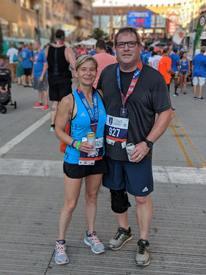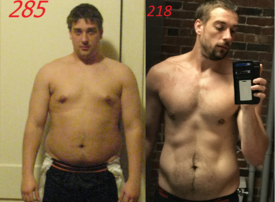Lifting twice a week- Best bang for your buck?

lporter229
Posts: 4,907 Member
I recently joined a gym so that I can start a regular lifting routine. My main goal is to gain overall strength and flexibility, particular to prevent future running injuries. I would like to lift twice per week, hopefully Tuesday and Thursday. I can probably spend up to and hour each day. Does anyone have any suggestions on specific exercises or plans that will give me the best results on this schedule? Am I better off working upper body one day and legs the other, or doing a full body workout each day?
Just for additional info, I am not entirely new to lifting, but my experience is limited to dumbbells. I have done NROLFW and P90X in my basement using only dumbbells and I have never had anyone critique my form, so I am still a little sketchy in that area as far as my confidence goes.
In addition to the 2 days of lifting, I plan to do the P90X3 videos, which are mainly focused on balance and agility along with body weight or light weight exercises. I can arrange them so that I am doing yoga or cardio on lifting days. I also swim for 30 minutes M,W, and F and plan to slowly start incorporating running back into my program too (currently not running due to hamstring tendinitis). Will this give me sufficient recovery time to make my lifting effective?
thanks in advance for the help.
Just for additional info, I am not entirely new to lifting, but my experience is limited to dumbbells. I have done NROLFW and P90X in my basement using only dumbbells and I have never had anyone critique my form, so I am still a little sketchy in that area as far as my confidence goes.
In addition to the 2 days of lifting, I plan to do the P90X3 videos, which are mainly focused on balance and agility along with body weight or light weight exercises. I can arrange them so that I am doing yoga or cardio on lifting days. I also swim for 30 minutes M,W, and F and plan to slowly start incorporating running back into my program too (currently not running due to hamstring tendinitis). Will this give me sufficient recovery time to make my lifting effective?
thanks in advance for the help.
1
Replies
-
I lift 2x per week and do a body weight routine for my 3rd day. If you're lifting 2x per week I would recommend full body. I'm sure there are 2x week programs out there, but I don't know what they are...my trainer helps me with my programming.4
-
Definitely full body each time3
-
Look up Starting Strength, Stronglifts, http://www.aworkoutroutine.com/the-beginner-weight-training-workout-routine/. Starting Strength is a good read regardless of the specific plan you choose - he goes into a lot of detail on form.4
-
Look up Starting Strength, Stronglifts, http://www.aworkoutroutine.com/the-beginner-weight-training-workout-routine/. Starting Strength is a good read regardless of the specific plan you choose - he goes into a lot of detail on form.
Well that looks easy enough! Or I should say simple enough. Thanks for the link.1 -
I think the Stronglifts/Starting Strength-type program is good advice. Those programs are easy and they are fun. And they produce notable results, rather quickly.
However, I have to say, having done this kind of weight training: It will make your running harder, and probably much slower, on the days after you lift. If you are doing the lifting properly, that is -- lifting what is heavy for you, lifting to fatigue.
That is going to mean there will be four days a week when you either do not run or do not run well.
That is great, if you are sure that is what you want. But be aware, that is what you are going to get.
Running coaches and other experts make much of cross-training and weight lifting these days. "Gotta have a strong core," is a mantra. But, I think if you look closely, what those coaches call "weight training" or "cross-training" is not as rigorous with the heavy weights as the routines of most weight lifters.
Alberto Salazar is a good example. He has become a prominent advocate of gym training. He says: 'You must lift.' But I have seen videos of him training runners. They are doing all kinds of weird balance ball, medicine ball and cable kinds of things. They are not hefting heavy barbells.
If they squat, it is not very heavy. At least not by a weight lifter's standards.
I have seen videos of Usain Bolt weight training also. Now, he is a big guy. He's world class. Weight lifting grows and trains your fast twitch fibers. So, if anybody would be lifting heavy, if it actually greatly benefited running, it might be him. But, one short clip of him on the leg press excepted, the weights he is shown lifting are not impressive. When I have seen him squat and the weight he uses appears to be less than 200 pounds, which should not be much for someone with his build. (Granted, he is tall and long, which is not an advantage for lifting.)
If you look up "cross-training for runners" on the Runners World website, I suspect you are going to find sit-ups and dumbbell lunges, not barbell deadlifts and weighted dips.
I think there is a reason for this. I think it may be kind of a misunderstanding when people talk about runners should lift.
I am a strong supporter of the idea that you mix things up to keep things fresh and avoid overuse injuries. And, the benefits of one activity transfer to another.
But if you want to run well, you gotta run. And, heavy weightlifting does not leave you the resources for serious running training.
I like to mix it up with hills and stairs and sprints some days, because it is good form training and low mileage.
I am not against lifting. I like to do it. But it is REALLY hard, if not impossible, to do two things well enough to get better at the same time.
Might I make a suggestion too? If you really do want to do some serious, heavy weightlifting/cross-training, check out Crossfit. You will have the same problem of heavy lifting that will interfere with your running sometimes. But it really does tend to incorporate more functional movement that might translate to running and other activities more than the limited routines you find in the gym. Plus, Crossfit workouts tend to have activities with a cardio component, at which you will excel. And, Crossfit mixes things up. One time you do box jumps and power cleans and jump rope. The next time you run 400s and do squats and pull-ups.
There are even entire Crossfit WODs that give you a good strength workout but are entirely body weight.
The only real downside to Crossfit, if you decide you like it, is that Crossfit is expensive.2 -
2 times a week feels far too infrequent to me. you'd have to do full body and need more than an hour and more than 2 days in between to rest if you're doing full body. But there is no way you can address legs/shoulders/back/chest/abs/biceps/triceps in 1 hour.0
-
What other option than full body?0
-
Yes, like said above, you will feel extra fatigue and be slower on your runs the day or 2 after.1
-
I have left normal weight lifts and moved to a single workout with a 35lb kettle bell. Instead of working individual muscle groups you work the whole body.0
-
I like doing full body twice a week. Something very similar to Stronglifts 5x5, but all five lifts each time.1
-
@GiddyupTim - I am just now getting around to seeing your response. Thanks for taking the time to write such a thoughtful response. All of your points are excellent ones and are very much in line with what I have discovered in the past, which is why I have limited myself to training with dumbbells and body weight exercises. The P90X videos, and especially the P90X3 videos, so far as I have done them, are very much geared toward the type of training you suggest is good for runners: light resistance with emphasis on balance, agility, etc. There is also an element of cardio thrown in there. However, since I am not doing much in the way of running right now, I was thinking that this might be a good time to try and increase my focus on the strength aspect of training. I think I am just looking for some new direction to take my training since I am frustrated with my current injury. Perhaps I am trying to do more than I need. Your response was a very helpful reminder that maybe this is not the type of training I need.0
-
Weight training has definitely seemed to improve my running (especially on uphills, and my recurring runner's knee) (except, of course, the day after when some of those muscles are still fatigued)(I think the added hamstring strength especially has made a difference).0
-
-
I'd probably do something like the following:
Day 1
Squat 3x5
Bench Press 4x8-10
Stiff Leg Deadlift 3x10
OHP 3x5
Barbell Row 4x8-10
Day 2
Conventional Deadlift 3x5
Close-Grip Bench 4x8-10
Squat 3x10
Incline Bench Press 3x5
Close-Grip BB Row 4x8-10
Starting out at say 50-60% of your 1 rep max, and working gradually up to 80-85% over 8-12 weeks, then test, and cycle it over again.0 -
2 times a week feels far too infrequent to me. you'd have to do full body and need more than an hour and more than 2 days in between to rest if you're doing full body. But there is no way you can address legs/shoulders/back/chest/abs/biceps/triceps in 1 hour.
:huh: It's really easy to hit all of those - as a beginner or early intermediate lifter - going full body. Squat, bench, row one session, followed by squat, ohp, deadlift the next (or vice versa, or switch the bench and ohp) an you can be in and out in ~45 minutes.1 -
2 times a week feels far too infrequent to me. you'd have to do full body and need more than an hour and more than 2 days in between to rest if you're doing full body. But there is no way you can address legs/shoulders/back/chest/abs/biceps/triceps in 1 hour.
This is what compound movements are for, bodybuilding style isolation exercises are not appropriate for everyone, I'd even say for most compound movements are superior, unless you're shoring up a weak area.0 -
lporter229 wrote: »My main goal is to gain overall strength and flexibility, particular to prevent future running injuries.
If you haven't done so already, i suggest getting your running form assessed by a sports physical therapist - preferably outside, after you've done a long run or strength training, so you're fatigued (amplifies form issues). 0
0 -
I just started with a 3 day full body routine called Ice Cream Fitness (ICF). There are two workouts Set A and B and I am sure you could modify it to use twice a week.0
-
If you haven't tried PiYo and want to add to body weight routines...its the slow, difficult strength training of Pilates, the flexibility of Yoga, and then speeds them both up to a cardio pace so that you have to be strong, flexible, and nimble to hold form and not fall on your face.0
-
I only had the 2 days a week when started lifting, so i did stronglifts 5x5 on those 2 days (plus some accessory stuff). This meant I was squatting 2x a week and doing the other lifts 1x. Obviously I made slower progress than if I could have managed 3x a week but I still progressed. Once I plateaued I moved on to 5/3/1 again over 2 days instead of the 4 prescribed, and am still doing that 7 months on and making progress0
-
2 times a week feels far too infrequent to me. you'd have to do full body and need more than an hour and more than 2 days in between to rest if you're doing full body. But there is no way you can address legs/shoulders/back/chest/abs/biceps/triceps in 1 hour.
Full body workouts with compound moves hit all those areas/muscles.
Yes it can be done in under an hour.
One day recovery in between is fine.3 -
I lift twice a week, an hour a session. Broadly, because it varies depending on my running schedule/any injury/etc, I start with either deadlifts or split squats - hammer them heavy and hard. Then an upper body superset of agonist/antagonist pairs + agility/plyometric work. Examples: pull ups + shoulder press, push ups + inverted rows, combined with exercises like box jumps, squat jumps, base touches etc. Then a final superset of core + any other random thing my personal trainer wants to throw at me (including weighted balls).0
This discussion has been closed.
Categories
- All Categories
- 1.4M Health, Wellness and Goals
- 398.1K Introduce Yourself
- 44.7K Getting Started
- 261K Health and Weight Loss
- 176.4K Food and Nutrition
- 47.7K Recipes
- 233K Fitness and Exercise
- 462 Sleep, Mindfulness and Overall Wellness
- 6.5K Goal: Maintaining Weight
- 8.7K Goal: Gaining Weight and Body Building
- 153.5K Motivation and Support
- 8.4K Challenges
- 1.4K Debate Club
- 96.5K Chit-Chat
- 2.6K Fun and Games
- 4.8K MyFitnessPal Information
- 12 News and Announcements
- 21 MyFitnessPal Academy
- 1.5K Feature Suggestions and Ideas
- 3.2K MyFitnessPal Tech Support Questions















